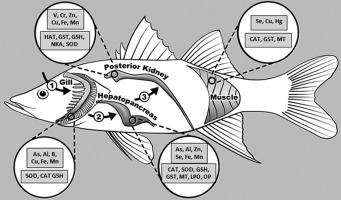Ecotoxicology and Environmental Safety ( IF 6.8 ) Pub Date : 2018-06-07 , DOI: 10.1016/j.ecoenv.2018.05.068 Iara da C. Souza , Mariana Morozesk , Marina M. Bonomo , Vinicius C. Azevedo , Marise M. Sakuragui , Michael Elliott , Silvia T. Matsumoto , Daniel A. Wunderlin , María V. Baroni , Magdalena V. Monferrán , Marisa N. Fernandes

|
Metal/metalloid accumulation in fish organs elicits biochemical responses indicating the overall fish and environmental health status. This study evaluated the bioaccumulation of metals and metalloid in relation to a suite of biochemical biomarkers (superoxide dismutase, catalase, glutathione-S-transferase, Na+/K+-ATPase, H+-ATPase, acetylcholinesterase activities and the levels of glutathione, metallothionein, lipid peroxidation and oxidized protein) in different organs of fish, Centropomus parallelus, in Vitória Bay and Santa Cruz estuaries (State of Espírito Santo, Brazil) with distinct contamination levels. Metal and metalloid concentrations differ in each organ and were significantly higher in winter than in summer. Chemometric evaluation performed between metal/metalloid accumulation and the biomarkers revealed a complex scenario in which the biomarker responses depend on both metal accumulation and organ/tissue sensitivity. The metal levels in gills indicate fish contamination mainly via water and the low sensitivity of this organ to most metals. Biomarker responses suggested that the metal elimination pathway is through the gills and kidney. The hepatopancreas and kidneys were the most important detoxification organs while muscle was the less reactive tissue. In general, the finding suggested that, C. parallelus is partly able to tolerate such metal contamination. However, it is emphasized that the biomarker responses imply an energetic cost and may affect the growth rate and reproduction. Given the ecological and economic importance of C. parallelus, the level of toxic metals/metalloids in juvenile fish is an important early-warning for the maintenance, conservation and commercial use of this species.
中文翻译:

新热带河口对食用鱼(Centropomus parallelus)器官中金属/准金属积累的差异生化响应
鱼器官中的金属/准金属积累引起生化反应,表明鱼的总体状况和环境健康状况。这项研究评估了金属和类金属与一系列生化生物标记物(超氧化物歧化酶,过氧化氢酶,谷胱甘肽-S-转移酶,Na + / K + -ATPase,H + -ATPase,乙酰胆碱酯酶活性以及谷胱甘肽,金属硫蛋白,脂质水平)的生物蓄积性在鱼的不同器官的过氧化和氧化的蛋白质),Centropomus parallelus位于Vitória湾和圣克鲁斯河口(巴西圣埃斯皮里图州),污染物水平明显不同。每个器官的金属和准金属浓度不同,冬季明显高于夏季。在金属/类金属积累与生物标志物之间进行的化学计量学评估揭示了一个复杂的场景,其中生物标志物的响应取决于金属积累和器官/组织的敏感性。s中的金属含量表明鱼类主要通过水污染,并且该器官对大多数金属的敏感性较低。生物标志物的反应表明,金属清除途径是通过the和肾脏。肝胰脏和肾脏是最重要的排毒器官,而肌肉是反应性较低的组织。总的来说,该发现表明,C.parallelus能够部分地忍受这种金属污染。然而,要强调的是,生物标志物的反应暗示了高能的代价,并可能影响生长速率和繁殖。鉴于平行线虫的生态和经济重要性,幼鱼中有毒金属/准金属的含量是对该物种的维护,保存和商业使用的重要预警。



























 京公网安备 11010802027423号
京公网安备 11010802027423号